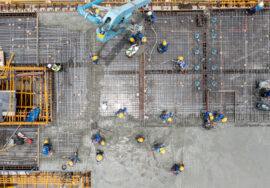
How to Improve Collaboration in Construction Projects
How to Improve Collaboration in Construction Projects
Improve Collaboration in Construction: Effective collaboration is key to the success of any construction project. With multiple stakeholders involved—contractors, architects, engineers, project managers, and clients—ensuring smooth communication and teamwork is crucial to keeping projects on track, within budget, and meeting quality standards. Poor collaboration can lead to delays, cost overruns, and conflicts, so improving teamwork is essential for a successful outcome.
In this blog, we’ll discuss how to improve collaboration in construction projects and the benefits of fostering a collaborative working environment.
The Importance of Collaboration in Construction
Construction projects involve a variety of moving parts and require constant coordination between teams. When collaboration is effective, it leads to:
- Improved communication: All parties have access to the same information, which reduces misunderstandings.
- Faster decision-making: Teams can address challenges quickly when they are aligned and working together.
- Reduced risks: Collaboration helps in identifying potential problems early, allowing teams to address issues before they escalate.
- Better quality: Effective teamwork ensures that everyone is working toward the same goals, leading to higher-quality results.
Now, let’s explore some strategies for improving collaboration in construction projects.
1. Use Digital Collaboration Tools
The construction industry has embraced digital tools that streamline communication and enhance collaboration among teams. Cloud-based platforms like Procore, Buildertrend, and PlanGrid allow stakeholders to share documents, track progress, and communicate in real-time. These tools centralize project information, making it easily accessible to all parties involved. This helps reduce the chances of miscommunication and ensures everyone stays on the same page.

2. Encourage Open Communication
Open and transparent communication is the foundation of effective collaboration. It’s essential to establish clear communication channels from the outset of a project. This includes regular meetings, updates, and open lines of communication between all stakeholders. Teams should be encouraged to share feedback, ask questions, and report concerns without hesitation. This fosters a culture of trust and mutual respect.
3. Foster a Collaborative Culture
Creating a collaborative culture requires building strong relationships among team members. Project managers can foster this by promoting teamwork, respect, and shared responsibility. Encourage cross-functional teams to work together, and ensure that all team members are aligned on project goals. Celebrating small wins and acknowledging individual and team contributions can help boost morale and strengthen collaboration.
4. Define Roles and Responsibilities Clearly
One common cause of poor collaboration is unclear roles and responsibilities. From the start of a project, clearly define the roles of each team member. When everyone knows their specific duties and how their work fits into the larger project, it minimizes confusion and ensures smoother collaboration. Having well-defined responsibilities also helps prevent task overlap or missed assignments.
5. Hold Regular Project Meetings
Frequent project meetings are essential for maintaining collaboration throughout the construction process. These meetings can be used to track progress, address challenges, and ensure that everyone is aligned. Weekly or bi-weekly meetings help teams stay connected and ensure that everyone is working toward the same objectives. Project managers should encourage open dialogue during these meetings, allowing team members to share updates and concerns.
6. Use Integrated Project Delivery (IPD)
Integrated Project Delivery (IPD) is a collaborative approach where all stakeholders—owners, architects, contractors, and subcontractors—work together from the project’s inception. This model fosters collaboration by aligning the interests of all parties. IPD helps reduce risks, improves cost management, and accelerates decision-making since everyone is involved from the early stages of the project.
7. Provide Training and Support
Construction projects involve the use of various tools, technologies, and methodologies. To improve collaboration, ensure that all team members are properly trained in the tools and processes being used. Regular training sessions help keep everyone up to date on the latest project management software, safety protocols, and industry best practices. This reduces errors, enhances productivity, and ensures everyone is working with the same level of understanding.
8. Establish Conflict Resolution Mechanisms
Disagreements are inevitable in construction projects, but they shouldn’t derail progress. To improve collaboration, it’s important to have conflict resolution mechanisms in place. Establish clear procedures for resolving disputes, and ensure that all parties are aware of these processes. Encouraging a proactive approach to resolving issues can prevent small problems from escalating and disrupting the project.
9. Share Information Freely
Information is key to collaboration. Sharing relevant documents, reports, and updates in a timely manner helps everyone stay informed and avoid unnecessary delays. By ensuring that all stakeholders have access to the same information, you can reduce the risk of errors and miscommunication. Digital platforms allow for the seamless exchange of information, keeping everyone in the loop.
10. Monitor and Adjust Collaboration Efforts
Finally, improving collaboration is an ongoing process. Project managers should regularly monitor the effectiveness of collaboration efforts and make adjustments as needed. This might involve refining communication protocols, reevaluating team dynamics, or introducing new tools. By continuously improving collaboration practices, you can ensure that projects run smoothly and meet their goals.
Benefits of Effective Collaboration
1. Enhanced Efficiency
When teams work together effectively, tasks are completed faster, decisions are made more quickly, and the project moves forward without unnecessary delays.
2. Cost Savings
Improved collaboration leads to fewer mistakes and rework, which helps keep the project within budget. Additionally, faster decision-making reduces downtime and prevents costly delays.
3. Higher Quality Outcomes
Collaboration ensures that all team members are aligned on the project’s goals and standards. This leads to better-quality construction and a more successful project overall.
4. Increased Satisfaction
Effective collaboration improves relationships between stakeholders, leading to higher levels of satisfaction for clients, contractors, and all involved parties.
Conclusion
Improve Collaboration in Construction ; Collaboration is vital to the success of construction projects. By utilizing digital tools, promoting open communication, fostering a collaborative culture, and clearly defining roles, construction teams can work together more effectively. Implementing these best practices will lead to improved efficiency, cost savings, and higher-quality outcomes. Collaboration is not just about working together—it’s about building a stronger, more successful project.
For more construction project management tips, contact us.
External Links:
- Explore top digital tools for collaboration on Procore.
- Learn more about Integrated Project Delivery (IPD) on Construction Dive.
Read more related articles to enhance your knowledge and make informed decisions
10 Essential Steps in the Building Construction Process
How to Choose the Right Materials for Your Construction Project








